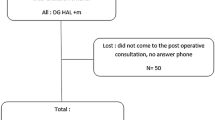Abstract
Purpose
Doppler-guided haemorrhoidal artery ligation (DGHAL) is a minimally invasive surgical technique used to treat symptomatic haemorrhoids. In 2005, the DGHAL proctoscope was redesigned to incorporate a window through which a recto anal repair (RAR) could be performed to improve the outcome in patients with significant prolapse symptoms. The aim of this study was to observe the outcome of a series of consecutive DGHAL–RAR procedures.
Method
Seventy-seven consecutive patients (49 male) underwent DGHAL–RAR for symptomatic haemorrhoids and were reviewed for a minimum of 6 months post-surgery.
Results
Fifty-seven (74%) of patients presented with both prolapse and bleeding symptoms. The median number of DGHALs performed was six, and the median number of RARs was two. Most (96%) patients were discharged the same day. At follow-up, 11 patients complained of recurrent symptoms, five of prolapse, four of bleeding and two of pruritus. Eight patients suffered with post-operative anal fissures. The procedure is recommended by 84.4% of patients 6 weeks post-surgery.
Conclusion
DGHAL–RAR is safe, effective and well tolerated. It reduces the need for potentially dangerous excisional procedures. The RAR component is an effective addition to DGHAL in the short term for the treatment of prolapse, but longer follow-up will be required to demonstrate durability of the technique.



Similar content being viewed by others
References
National Institute for Health and Clinical Excellence (2007) Stapled haemorrhoidopexy for the treatment of haemorrhoids. NICE technology appraisal guidance 128
Milligan E, Morgan C (1937) Surgical anatomy of the anal canal and operative treatment of hemorrhoids. Lancet 2:1119–1124
Ferguson JA, Heaton JR (1959) Closed hemorrhoidectomy. Dis Colon Rectum 2:176–179
Mehigan BJ, Monson JR, Hartley JE (2000) Stapling procedure for haemorrhoids versus Milligan-Morgan haemorrhoidectomy: randomised controlled trial. Lancet 355:782–785
Morinaga K, Hasuda K, Ikeda T (1995) A novel therapy for internal hemorrhoids: ligation of the hemorrhoidal artery with a newly devised instrument (Moricorn) in conjunction with a Doppler flow meter. Am J Gastroenterol 90:610–613
Scheyer M, Antonietti E, Rollinger G, Mall H, Arnold S (2006) Doppler-guided hemorrhoidal artery ligation. Am J Surg 191:89–93
Bursics A, Morvay K, Kupcsulik P, Flautner L (2004) Comparison of early and 1-year follow-up results of conventional hemorrhoidectomy and hemorrhoid artery ligation: a randomized study. Int J Colorectal Dis 19:176–180
Dal Monte PP, Tagariello C, Sarago M et al (2007) Transanal haemorrhoidal dearterialisation: nonexcisional surgery for the treatment of haemorrhoidal disease. Tech Coloproctol 11:333–338
Wilkerson P, Strbac M, Reece-Smith H, Middleton S (2008) Doppler-guided haemorrhoidal artery ligation: long-term outcome and patient satisfaction. Colorectal Dis 11:394–400
Conaghan P, Farouk R (2009) Doppler-guided hemorrhoid artery ligation reduces the need for conventional hemorrhoid surgery in patients who fail rubber band ligation treatment. Dis Colon Rectum 52:127–130
Sardinha TC, Corman ML (2002) Hemorrhoids. Surg Clin North Am 82:1153–1167, vi
Bleday R, Pena JP, Rothenberger DA, Goldberg SM, Buls JG (1992) Symptomatic hemorrhoids: current incidence and complications of operative therapy. Dis Colon Rectum 35:477–481
Thomson WH (1975) The nature of haemorrhoids. Br J Surg 62:542–552
Milson JW (1992) Hemorrhoidal disease. In: Beck DE, Wexner SD (eds) Fundamentals of anorectal surgery. Saunders, Philadelphia, pp 192–214
Shanmugam V, Thaha MA, Rabindranath KS, Campbell KL, Steele RJ, Loudon MA (2005) Rubber band ligation versus excisional haemorrhoidectomy for haemorrhoids. Cochrane Database Syst Rev CD005034
Middleton SB, Lovegrove RE, Reece-Smith H (2008) Management of haemorrhoids: symptoms govern treatment. BMJ 336:461
Classic articles in colonic and rectal surgery. Frederick Salmon 1796-1868. Dis Colon Rectum 1983; 26:754–758
Muzi MG, Milito G, Nigro C et al (2007) Randomized clinical trial of LigaSure and conventional diathermy haemorrhoidectomy. Br J Surg 94:937–942
Longo A (1998) Treatment of hemorrhoids disease by reduction of mucosa and hemorrhoidal prolapse with a circular suturing device: a new procedure. In: Sixth World Congress of Endoscopic Surgery, Rome, Italy
Jayaraman S, Colquhoun PH, Malthaner RA (2007) Stapled hemorrhoidopexy is associated with a higher long-term recurrence rate of internal hemorrhoids compared with conventional excisional hemorrhoid surgery. Dis Colon Rectum 50:1297–1305
Shao WJ, Li GC, Zhang ZH, Yang BL, Sun GD, Chen YQ (2008) Systematic review and meta-analysis of randomized controlled trials comparing stapled haemorrhoidopexy with conventional haemorrhoidectomy. Br J Surg 95:147–160
Jayaraman S, Colquhoun PH, Malthaner RA (2006) Stapled versus conventional surgery for hemorrhoids. Cochrane Database Syst Rev CD005393
Cheetham MJ, Cohen CR, Kamm MA, Phillips RK (2003) A randomized, controlled trial of diathermy hemorrhoidectomy vs. stapled hemorrhoidectomy in an intended day-care setting with longer-term follow-up. Dis Colon Rectum 46:491–497
Ripetti V, Caricato M, Arullani A (2002) Rectal perforation, retropneumoperitoneum, and pneumomediastinum after stapling procedure for prolapsed hemorrhoids: report of a case and subsequent considerations. Dis Colon Rectum 45:268–270
Felice G, Privitera A, Ellul E, Klaumann M (2005) Doppler-guided hemorrhoidal artery ligation: an alternative to hemorrhoidectomy. Dis Colon Rectum 48:2090–2093
Faucheron JL, Gangner Y (2008) Doppler-guided hemorrhoidal artery ligation for the treatment of symptomatic hemorrhoids: early and three-year follow-up results in 100 consecutive patients. Dis Colon Rectum 51:945–949
Author information
Authors and Affiliations
Corresponding author
Rights and permissions
About this article
Cite this article
Forrest, N.P., Mullerat, J., Evans, C. et al. Doppler-guided haemorrhoidal artery ligation with recto anal repair: a new technique for the treatment of symptomatic haemorrhoids. Int J Colorectal Dis 25, 1251–1256 (2010). https://doi.org/10.1007/s00384-010-0951-4
Accepted:
Published:
Issue Date:
DOI: https://doi.org/10.1007/s00384-010-0951-4




